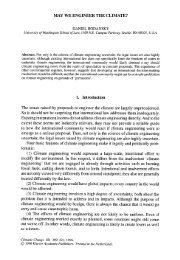ThorEA - Towards an Alternative Nuclear Future.pdf
ThorEA - Towards an Alternative Nuclear Future.pdf
ThorEA - Towards an Alternative Nuclear Future.pdf
Create successful ePaper yourself
Turn your PDF publications into a flip-book with our unique Google optimized e-Paper software.
Chapter 1: Thorium-fuelled ADSRs <strong>an</strong>d their potential UK <strong>an</strong>d global impact continued<br />
1.2 The adv<strong>an</strong>tages of thorium-fuelled ADSR<br />
technology in <strong>an</strong> exp<strong>an</strong>ding global nuclear l<strong>an</strong>dscape<br />
The energy sector has been a key element underpinning<br />
economic growth since the industrial revolution. Today it is<br />
becoming a bottleneck for further development as the global<br />
need for low carbon options becomes more acute <strong>an</strong>d the<br />
dem<strong>an</strong>d for secure energy is increases in emerging economies.<br />
For m<strong>an</strong>y industrialised countries the nuclear industry has<br />
helped to alleviate this bottleneck, playing a signific<strong>an</strong>t role<br />
in energy provision <strong>an</strong>d claiming 15% of global electricity<br />
Surge in World<br />
energy dem<strong>an</strong>d<br />
Climate ch<strong>an</strong>ge<br />
threats<br />
Climate ch<strong>an</strong>ge threats: for the last 20 years<br />
awareness on the rising of global temperatures <strong>an</strong>d<br />
its correlation with greenhouse gas emission have<br />
had <strong>an</strong> enormous impact on the public perception of,<br />
<strong>an</strong>d future prospects for, nuclear power;<br />
Surge in world energy dem<strong>an</strong>d: the world’s rapid<br />
economic growth (<strong>an</strong> unprecedented 4% average during<br />
the last decade) has fuelled <strong>an</strong> increase in global energy<br />
dem<strong>an</strong>d which is barely followed by supply, triggering<br />
a surge in energy prices <strong>an</strong>d volatility;<br />
Concerns for safety, nuclear waste <strong>an</strong>d proliferation:<br />
the 1986 Chernobyl accident did much to set back<br />
the clock of nuclear development <strong>an</strong>d exp<strong>an</strong>sion;<br />
long lived nuclear waste <strong>an</strong>d its effects upon the<br />
environment are a growing concern; due to its origins,<br />
nuclear power has traditionally been linked to military<br />
applications, <strong>an</strong>d although recently commercial<br />
nuclear power is succeeding in decoupling itself from<br />
such connections in public perception, concerns<br />
about proliferation in the context of rogue states <strong>an</strong>d<br />
terrorism remain.<br />
Technological ch<strong>an</strong>ges <strong>an</strong>d innovation:<br />
technological developments both in the nuclear<br />
industry, such as Generation IV, <strong>an</strong>d renewable<br />
energies, are shaping the future of nuclear power;<br />
additionally potential niches are opening (e.g. water<br />
desalination, hydrogen production) with very few<br />
base-load alternatives in sight;<br />
12 <strong>Towards</strong> <strong>an</strong> <strong>Alternative</strong> <strong>Nuclear</strong> <strong>Future</strong><br />
Concerns for<br />
safety, waste <strong>an</strong>d<br />
proliferaction<br />
<strong>Nuclear</strong><br />
power<br />
market<br />
generation with <strong>an</strong>nual sales of the order of £200bn. Subject<br />
to issues of sustainability <strong>an</strong>d proliferation resist<strong>an</strong>ce, a wider<br />
global deployment of nuclear technology is inevitable if the<br />
growing dem<strong>an</strong>d for electrical energy is to be met.<br />
Yet, despite its size <strong>an</strong>d signific<strong>an</strong>ce, the nuclear power<br />
industry is subject to numerous external parameters working<br />
both for <strong>an</strong>d against its further exp<strong>an</strong>sion. Some of the major<br />
factors shaping the industry, are summarised by Figure 2:<br />
Ch<strong>an</strong>ges in public<br />
opinion <strong>an</strong>d<br />
regulations<br />
Technological<br />
ch<strong>an</strong>ges in<br />
innovation<br />
Figure 2. <strong>Nuclear</strong> power market <strong>an</strong>alysis, including major factors influencing its evolution.<br />
Ch<strong>an</strong>ges in public opinion <strong>an</strong>d regulations: the<br />
previous factors have strongly influenced the public<br />
perception of nuclear power; countries such as<br />
Germ<strong>an</strong>y are re-assessing their phase-out decision,<br />
whereas others, such as China <strong>an</strong>d India, will<br />
undeniably rely on nuclear power to sustain their<br />
rapid growth.<br />
The combination of these factors suggests that the global<br />
energy market is ready for the deployment of a new type<br />
of nuclear system which is inherently safe, fuelled from a<br />
sustainable, low waste source, <strong>an</strong>d which c<strong>an</strong> be exported<br />
globally without igniting fears of potential proliferation<br />
(Appendix III).<br />
For the UK the development of such<br />
a nuclear system, exemplified by<br />
thorium-fuelled ADSR technology,<br />
would guar<strong>an</strong>tee technological<br />
leadership in the global energy<br />
sector, with commercial returns far<br />
larger th<strong>an</strong> the initial investment.



